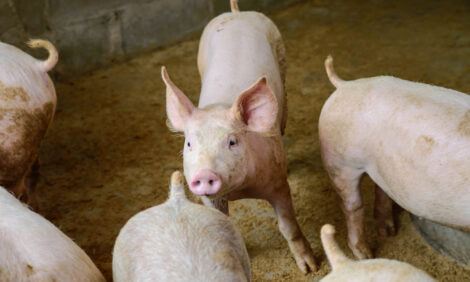



Mexican producer profit is currently unsurpassed in most countries
CANADA - Jim Long's Weekly Pork Commentary this week looking at Mexico's successful producers profits. Jim Long President, Baconmaker Genetics / Wood Lynn Farms, Inc. |
Mexico
We attended Mexico's Congress of Swine Producers held in Vera Cruz last week. The event's participants included producers, exhibitors and industry support people. The mood of the Congress could best be described as upbeat but tempered by apprehension.In Mexico, hogs are sold on a live weight basis and at 100 kilograms/220 lbs. Here is a snapshot of current Mexican production economics in pesos/dollars:
| Price, Break even, Profit estimates | ||
| Category | Pesos | US$ |
| Live hog price | 13/kg | .53/lb |
| Break even | 10.5/kg | .43/lb |
| Profit/hd | 275 | 25 |
Mexican producer profit is possibly unsurpassed in most, if not all, countries of the world at this time. With profits most Canadian and U.S. producers would die for, why would the Mexican Producers' generally upbeat attitude be somewhat tempered by apprehension? Here are some factors:
The two years just past have been difficult in Mexico. Many months were near, or below, the cost of production.
Credit is hard to facilitate and it's expensive (north of 15%).
The regional market of the Yucatan (Cancun area) is recovering from the devastation of a hurricane a year ago. It destroyed an estimated 20-25% of the swine infrastructure and a proportional percentage of production. There was little insurance and limited government aid. The financial effect on the industry is debilitating. We heard of 1 uninsured producer with losses of 8 million dollars.
Mexico, like most countries, has different regional prices and costs. Local prices are generally adjusted by proximity to Mexico City's huge population base. Cost of production is predicated on access to local and imported feedstuffs. Both price and cost of production have up to 20% variability regionally.
Cost of grain and protein in Mexico is dictated by U.S. supply, price and government support programs. Mexico is a net importer of feed ingredients and the extra transportation costs make Mexico's cost of production for swine higher than in the U.S.
Over the last few months extra meat and poultry supply in the U.S. has been imported to Mexico. This, in turn, has leveraged Mexico's poultry and livestock prices lower.
Over the last two years the Mexican breeding herd has declined due to lower margins.
Cause:
Lower beef and pork production in the U.S. will limit imports to Mexico.
Higher prices in the U.S. for hogs will maintain and enhance Mexico's prices.
Record and/or near record cattle prices in the U.S. will stimulate record feeder cattle exports from Mexico to U.S. feed lots. This will be further enhanced by the U.S. ban on cattle imports from Canada. Obviously, any cattle exported from Mexico decreases domestic availability of beef, helping local beef and pork prices.
Over the next year we expect prices in Mexico will, conservatively, average 13-14 pesos/kg (53-57 cents/lb live weight U.S.)
Profit will exceed $25/hd.
We see another 10% upside to these prices if our scenario bears out that U.S. prices could exceed current lean hog Futures prices because of lower pork and beef supply than the Futures expect. Producing hogs in Mexico in 2004 should be a good business.
Mexico's higher cost of production has stimulated producers there to aggressively search for and implement technologies that will enhance efficiencies---whether it be the latest software from PigChamp, new feeding equipment or better genetics. The demand of the Mexican market weeds out inferior product lines.
Personal Note
At the Congress we were able to spend considerable time with Manuel Perez, the owner and managing director of the website, Porcicultura.com. Porcicultura.com is the vehicle for our commentary throughout the Spanish-speaking world. We believe the industry is fortunate to have a professional like Manuel committed to getting relevant pork industry news and information to producers in real time. Like us, Manuel is a producer who feels the highs and lows of this industry. His soul is in the business. Relevant information and facts are a major key to any successful business and Manuel is committed to deliver it to his readership base. We feel fortunate to be associated with him.
| Published with permission from |
Information provided by |
Source: Jim Long, www.baconmaker.com. Reproduced courtesy Farms.com - 6th October 2003








